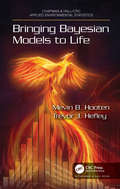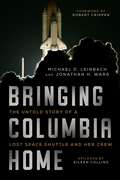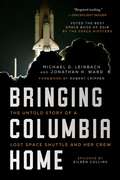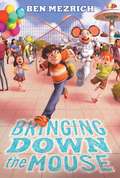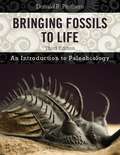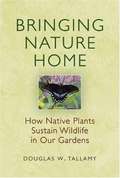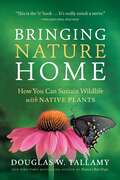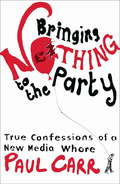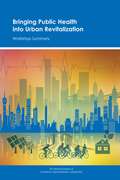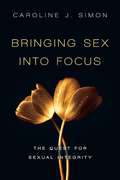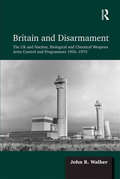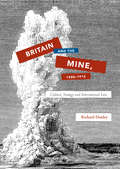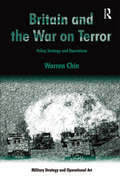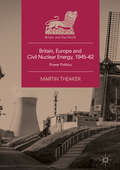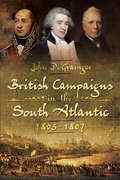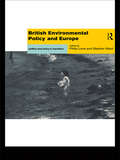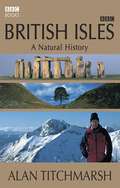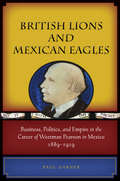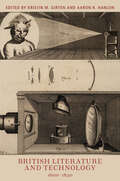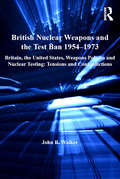- Table View
- List View
Bringing Back the Woolly Mammoth: The Great Debate (Fountas & Pinnell Classroom, Guided Reading Grade 5)
by Tina KafkaTURNING BACK TIME The woolly mammoth, with its long curved tusks and shaggy coat, became extinct thousands of years ago. Now some scientists want to turn back time and bring the woolly mammoth back to life, but others are strongly opposed. NIMAC-sourced textbook
Bringing Bayesian Models to Life (Chapman & Hall/CRC Applied Environmental Statistics)
by Mevin B. Hooten Trevor J. HefleyBringing Bayesian Models to Life empowers the reader to extend, enhance, and implement statistical models for ecological and environmental data analysis. We open the black box and show the reader how to connect modern statistical models to computer algorithms. These algorithms allow the user to fit models that answer their scientific questions without needing to rely on automated Bayesian software. We show how to handcraft statistical models that are useful in ecological and environmental science including: linear and generalized linear models, spatial and time series models, occupancy and capture-recapture models, animal movement models, spatio-temporal models, and integrated population-models. Features: R code implementing algorithms to fit Bayesian models using real and simulated data examples. A comprehensive review of statistical models commonly used in ecological and environmental science. Overview of Bayesian computational methods such as importance sampling, MCMC, and HMC. Derivations of the necessary components to construct statistical algorithms from scratch. Bringing Bayesian Models to Life contains a comprehensive treatment of models and associated algorithms for fitting the models to data. We provide detailed and annotated R code in each chapter and apply it to fit each model we present to either real or simulated data for instructional purposes. Our code shows how to create every result and figure in the book so that readers can use and modify it for their own analyses. We provide all code and data in an organized set of directories available at the authors' websites.
Bringing Columbia Home: The Untold Story of a Lost Space Shuttle and Her Crew
by Michael Leinbach Jonathan Ward Eileen Collins Robert CrippenFor the first time, here is the definitive inside story of the Columbia disaster and recovery and the inspiring message it ultimately holds. <P><P>In the aftermath of tragedy, people and communities came together to help bring home the remains of the crew and nearly 40 percent of shuttle, an effort that was instrumental in piecing together what happened so the shuttle program could return to flight and complete the International Space Station. <P><P>Bringing Columbia Home shares the deeply personal stories that emerged as NASA employees looked for lost colleagues and searchers overcame immense physical, logistical, and emotional challenges and worked together to accomplish the impossible. <P><P> Featuring a foreword and epilogue by astronauts Robert Crippen and Eileen Collins, and dedicated to the astronauts and recovery search persons who lost their lives, this is an incredible, compelling narrative about the best of humanity in the darkest of times and about how a failure at the pinnacle of human achievement became a story of cooperation and hope.
Bringing Columbia Home: The Untold Story of a Lost Space Shuttle and Her Crew
by Jonathan H. Ward Eileen Collins Robert Crippen Michael D. LeinbachTimed to release for the 15th Anniversary of the Columbia space shuttle disaster, this is the epic true story of one of the most dramatic, unforgettable adventures of our time.On February 1, 2003, Columbia disintegrated on reentry before the nation’s eyes, and all seven astronauts aboard were lost. Author Mike Leinbach, Launch Director of the space shuttle program at NASA’s John F. Kennedy Space Center was a key leader in the search and recovery effort as NASA, FEMA, the FBI, the US Forest Service, and dozens more federal, state, and local agencies combed an area of rural east Texas the size of Rhode Island for every piece of the shuttle and her crew they could find. Assisted by hundreds of volunteers, it would become the largest ground search operation in US history. This comprehensive account is told in four parts: Parallel Confusion Courage, Compassion, and Commitment Picking Up the Pieces A Bittersweet VictoryFor the first time, here is the definitive inside story of the Columbia disaster and recovery and the inspiring message it ultimately holds. In the aftermath of tragedy, people and communities came together to help bring home the remains of the crew and nearly 40 percent of shuttle, an effort that was instrumental in piecing together what happened so the shuttle program could return to flight and complete the International Space Station. Bringing Columbia Home shares the deeply personal stories that emerged as NASA employees looked for lost colleagues and searchers overcame immense physical, logistical, and emotional challenges and worked together to accomplish the impossible.Featuring a foreword and epilogue by astronauts Robert Crippen and Eileen Collins, and dedicated to the astronauts and recovery search persons who lost their lives, this is an incredible, compelling narrative about the best of humanity in the darkest of times and about how a failure at the pinnacle of human achievement became a story of cooperation and hope.
Bringing Down the Mouse
by Ben MezrichCharlie Lewis goes on a roller coaster ride of risk, math, and gaming in this middle grade novel that parallels the New York Times bestselling Bringing Down the House, which inspired the movie 21 with Kevin Spacey.Charlie Lewis is a nerd. All he's ever been good at is math--and he's really good at math. So good that he's recruited by a group of kids determined to game the system at the biggest theme park in the world--and win the grand prize. Soon Charlie is caught up in the excitement and thrill of using his math skills for awesomeness...but what's at stake may be more than he's willing to risk. How far will Charlie go for a chance at the ultimate reward?
Bringing Fossils to Life: An Introduction to Paleobiology
by Donald R. ProtheroOne of the leading textbooks in its field, Bringing Fossils to Life applies paleobiological principles to the fossil record while detailing the evolutionary history of major plant and animal phyla. It incorporates current research from biology, ecology, and population genetics, bridging the gap between purely theoretical paleobiological textbooks and those that describe only invertebrate paleobiology and that emphasize cataloguing live organisms instead of dead objects. For this third edition Donald R. Prothero has revised the art and research throughout, expanding the coverage of invertebrates and adding a discussion of new methodologies and a chapter on the origin and early evolution of life.
Bringing Nature Home: How Native Plants Sustain Wildlife In Our Gardens
by Douglas W. TallamyBy growing native plants, suburban gardeners can play an important role in helping create sustainable ecosystems. Believing that knowledge will generate interest in being part of the solution, Tallamy (entomology and wildlife ecology, U. of Delaware in Newark) explains why biodiversity is crucial and what to plant to encourage beneficial insects. The gently persuasive book includes color photos; a listing of landscape-worthy, wildlife-attracting native plants by U. S. region; summary table of host plants of butterflies and showy moths; and experimental evidence for the ability of native as vs. alien plants to attract beneficial insects. Annotation ©2008 Book News, Inc. , Portland, OR (booknews. com)
Bringing Nature Home: How You Can Sustain Wildlife With Native Plants
by Douglas W. TallamyThe pressures on wildlife populations today are greater than they have ever been and many gardeners assume they can remedy this situation by simply planting a variety of flowering perennials, trees, and shrubs. As Douglas Tallamy points out in this revelatory book, that assumption is largely mistaken. Wild creatures exist in a complex web of interrelationships, and often require different kinds of food at different stages of their development. There is an unbreakable link between native plant species and native wildlife. When native plant species disappear, the insects disappear, thus impoverishing the food source for birds and other animals. Fortunately, there is still time to reverse this alarming trend, and gardeners have the power to make a significant contribution toward sustainable biodiversity. By favoring native plants, gardeners can provide a welcoming environment for wildlife of all kinds. Healthy local ecosystems are not only beautiful and fascinating, they are also essential to human well-being. By heeding Douglas Tallamy's eloquent arguments and acting upon his recommendations, gardeners everywhere can make a difference.
Bringing Nature Home: How You Can Sustain Wildlife with Native Plants, Updated and Expanded
by Douglas W. Tallamy Rick Darke“If you cut down the goldenrod, the wild black cherry, the milkweed and other natives, you eliminate the larvae, and starve the birds. This simple revelation about the food web—and it is an intricate web, not a chain—is the driving force in Bringing Nature Home.” —The New York Times As development and subsequent habitat destruction accelerate, there are increasing pressures on wildlife populations. But there is an important and simple step toward reversing this alarming trend: Everyone with access to a patch of earth can make a significant contribution toward sustaining biodiversity. There is an unbreakable link between native plant species and native wildlife—native insects cannot, or will not, eat alien plants. When native plants disappear, the insects disappear, impoverishing the food source for birds and other animals. In many parts of the world, habitat destruction has been so extensive that local wildlife is in crisis and may be headed toward extinction.Bringing Nature Home has sparked a national conversation about the link between healthy local ecosystems and human well-being, and the new paperback edition—with an expanded resource section and updated photos—will help broaden the movement. By acting on Douglas Tallamy's practical recommendations, everyone can make a difference.
Bringing Nothing to the Party: True Confessions Of A New Media Whore
by Paul CarrA fascinating and hilarious expose of how a group of young opportunists, chancers and geniuses found instant fame and fortune by messing about on the web. And one man's attempt to follow in their footsteps.Having covered the first dot com boom, and founded a web-to-print publishing business during the second one, Paul counts many of the leading Internet entrepreneurs amongst his closest friends. These friendships mean he doesn't just attend their product launches and press conferences and speak at their events, but also gets invited to their ultra-exclusive networking events, and gets drunk at their parties.Paul has enjoyed this bizarre world of excess without having to live in it. To help the moguls celebrate raising millions of pounds of funding without having to face the wrath of the venture capitalists himself. But in 2006, Paul decided he didn't want to be a spectator any more. He had been harbouring a great dot com project of his own and decided it was time to do something about it.
Bringing Nothing to the Party: True Confessions Of A New Media Whore
by Paul CarrA fascinating and hilarious expose of how a group of young opportunists, chancers and geniuses found instant fame and fortune by messing about on the web. And one man's attempt to follow in their footsteps.Having covered the first dot com boom, and founded a web-to-print publishing business during the second one, Paul counts many of the leading Internet entrepreneurs amongst his closest friends. These friendships mean he doesn't just attend their product launches and press conferences and speak at their events, but also gets invited to their ultra-exclusive networking events, and gets drunk at their parties.Paul has enjoyed this bizarre world of excess without having to live in it. To help the moguls celebrate raising millions of pounds of funding without having to face the wrath of the venture capitalists himself. But in 2006, Paul decided he didn't want to be a spectator any more. He had been harbouring a great dot com project of his own and decided it was time to do something about it.
Bringing Public Health into Urban Revitalization: Workshop Summary
by Robert PoolA particularly valuable opportunity to improve public health arises when an urban area is being redesigned and rebuilt following some type of serious disruption, whether it is caused by a sudden physical event, such as a hurricane or earthquake, or steady economic and social decline that may have occurred over decades. On November 10, 2014, the Institute of Medicine's Roundtable on Environmental Health Sciences, Research, and Medicine held a workshop concerning the ways in which the urban environment, conceived broadly from factors such as air quality and walkability to factors such as access to fresh foods and social support systems, can affect health. Participants explored the various opportunities to reimagine the built environment in a city and to increase the role of health promotion and protection during the process of urban revitalization. Bringing Public Health into Urban Revitalization summarizes the presentations and discussions from this workshop.
Bringing Sex Into Focus: The Quest For Sexual Integrity
by Caroline J. SimonIn a culture that includes sex in everything from advertising to climbing the corporate ladder, it's easy to feel fuzzy about the true purpose and place of sexuality. In this book philosopher and ethicist Caroline J. Simon identifies six "lenses" through which people understand sex and sexuality: covenantal, procreative, expressive, romantic, power and "plain sex. " Guided by a virtue ethic, she applies those lenses to a variety of sexual scenarios, from flirtation and desire to marital sexuality, helping us to see what filters we run issues of sexuality through and how, properly ordered and weighted, they can help us achieve sexual integrity. Here is a book for anyone interested in developing a holistic, biblical sexual ethic that brings into focus the bewildering array of cultural sexual presentations we're surrounded by every day.
Britain and Disarmament: The UK and Nuclear, Biological and Chemical Weapons Arms Control and Programmes 1956-1975
by John R. WalkerSince the use of poison gas during the First World War and the dropping of atomic bombs on Japan at the end of the Second World War, nuclear, biological or chemical (NBC) weapons have registered high on the fears of governments and individuals alike. Recognising both the particular horror of these weapons, and their potential for inflicting mass death and destruction, much effort has been expended in finding ways to eliminate such weapons on a multi-lateral level. Based on extensive official archives, this book looks at how successive British governments approached the subject of control and disarmament between 1956 and 1975. This period reflects the UK's landmark decision in 1956 to abandon its offensive chemical weapons programme (a decision that was reversed in 1963, but never fully implemented), and ends with the internal travails over the possible use of CR (tear gas) in Northern Ireland. Whilst the issue of nuclear arms control has been much debated, the integration of biological and chemical weapons into the wider disarmament picture is much less well understood, there being no clear statement by the UK authorities for much of the period under review in this book as to whether the country even possessed such weapons or had an active research and development programme. Through a thorough exploration of government records the book addresses fundamental questions relating to the history of NBC weapons programmes, including the military, economic and political pressures that influenced policy; the degree to which the UK was a reluctant or enthusiastic player on the international arms control stage; and the effect of international agreements on Britain's weapons programmes. In exploring these issues, the study provides the first attempt to assess UK NBC arms control policy and practice during the Cold War.
Britain and the Mine, 1900–1915: Culture, Strategy And International Law
by Richard DunleyThis book examines Britain’s complex relationship with the mine in the years 1900-1915. The development of mine warfare represented a unique mix of challenges and opportunities for Britain in the years before the First World War. The mine represented the antithesis of British maritime culture in material form, and attempts were made to limit its use under international law. At the same time, mine warfare offered the Royal Navy a solution to its most difficult strategic problem. Richard Dunley explores the contested position occupied by the mine in the attitudes of British policy makers, and in doing so sheds new light on the overlapping worlds of culture, strategy and international law.
Britain and the War on Terror: Policy, Strategy and Operations (Military Strategy and Operational Art)
by Warren ChinWhy did Britain come to play such a prominent role in the war on terror and why did the military instrument come to be the dominant theme in the British prosecution of what was an ideological and political struggle? This book is an analysis of Britain’s war against Al Qaeda and the phenomenon of international terrorism which marked a paradigm shift in the nature and conduct of war in the twenty-first century. At the heart of the book is an attempt to understand why Britain, which possessed a wealth of experience in the conduct of counterterrorism, counterinsurgency and small wars, developed a strategic and operational design to defeat the Islamist threat which proved to be deeply flawed. In addressing this question the book explores the complex intellectual, doctrinal and geopolitical challenge posed by Al Qaeda and international terrorism and how and why the British response took the form that it did. In conducting this analysis the book raises important questions about the assumptions and perceptions of those in government who led the UK into this conflict, the nature of the civil military relationship in Britain and how well it functioned, and finally the competence of its security forces in being able to deal with this threat both domestically and overseas.
Britain, Europe and Civil Nuclear Energy, 1945–62: Power Politics (Britain and the World)
by Martin TheakerThis book examines the role played by civil nuclear energy in Britain’s relationship with Europe between the end of the Second World War and London’s first application to join the European Communities. Tracing the development of the British nuclear programme as it emerged as a global leader in constructing the world’s first atomic power stations, it analyses how the threat of energy shortages throughout the 1950s presented ministers with a golden opportunity to utilise nuclear cooperation as an instrument to influence the political shape of Europe. Importantly, this book will show how this chance was missed by ministers due to a combination of disorganization and diplomatic pressure, as well as a perennial lack of domestic resources. In so doing, this book joins the long-disconnected historiographies of European integration and nuclear energy to offer a new perspective on both scholarly fields.
British Campaigns in the South Atlantic, 1805–1807
by John D. GraingerBetween 1805 and 1807 the British mounted several expeditions into the South Atlantic aimed at weakening Napoleon's Spanish and Dutch allies. The targets were the Dutch colony on South Africa's Cape of Good Hope, which potentially threatened British shipping routes to India, and the Spanish colonies in the Rio de la Plata basin (now parts of Argentina and Uruguay). In 1805 an army of around 6,000 men was dispatched for the Cape under the highly-respected General David Baird. They were escorted and assisted by a naval squadron under Home Riggs Popham. The Cape surrendered in January 1806. Popham then persuaded Baird to lend him troops for an attack on Buenos Aires. Buenos Aires was taken in July but the paltry British force (around 2,400 men) was then besieged and forced to surrender in August. Popham was later court martialled for exceeding his orders.In Feb 1807 Montevideo was taken by a new (officially sanctioned) British force of 6,000 men. Whitelocke, the British Commander then attempted to retake Buenos Aires (not least to free British prisoners from the first attempt) but was defeated by unexpectedly fierce resistance stiffened by armed creoles and slaves. After heavy losses he signed an armistice, surrendering Montevideo and withdrawing all his forces. He too was court-martialled. One of the major themes of this new account is the strong Scottish connection Baird and Popham were both Scots, and the 71st Highlanders made up the main force in the Cape and Popham's adventure. Another is the unlooked for consequences of these actions. The arrival of Scottish Calvinist ministers in the Cape influenced the eventual development of apartheid, while successful resistance to the British, with little help from Spain, shaped and accelerated the independence movement in South America.
British Environmental Policy and Europe: Politics and Policy in Transition (Global Environmental Change Ser.)
by Stephen Ward Philip LoweThis book explores the effectiveness of the response of environmental groups and organisations in Britain in to the challenges of European integration. Examining the relative European orientation of British environmental policy, and the impact of British concerns on European environmental policy, the book examines issues of environmental diplomacy, institutional dynamics, and policy debates relating to specific concerns such as: * pollution * land use * transport * natural conservation Presenting a wealth of examples throughout, the book draws together contributions from leading academics and practitioners from institutions and organisations such as the DOE, European Commission, WWF and CPRE.
British Isles: A Natural History
by Alan TitchmarshAccompanying a major new BBC1 series presented by Alan Titchmarsh, British Isles: A Natural History is a fascinating journey through the natural history of Britain from its birth to the present day. Written in Alans uniquely readable style, the book chronicles the different periods in Britain's evolution, exploring everything from the geology and geography to the flora and fauna that make up the diverse landscapes of the British Isles. It also includes a gazetteer section detailing where you can explore for yourself Britain's natural treasures. Beautifully illustrated with 180 colour photographs, it will appeal to natural history enthusiasts and everyone who cares about the country they live in. The book contains the latest research gathered in the making of this new landmark series from the BBC's NHU in Bristol. Alan Titchmarsh is a bestselling BBC author and has sold over a million copies of his books which include How To Be A Gardener 1 and 2 and Royal Gardeners.
British Lions and Mexican Eagles: Business, Politics, and Empire in the Career of Weetman Pearson in Mexico, 1889-1919
by Paul GarnerBetween 1889 and 1919, Weetman Pearson became one of the world's most important engineering contractors, a pioneer in the international oil industry, and one of Britain's wealthiest men. At the center of his global business empire were his interests in Mexico. While Pearson's extraordinary success in Mexico took place within the context of unprecedented levels of British trade with and investment in Latin America, Garner argues that Pearson should be understood less as an agent of British imperialism than as an agent of Porfirian state building and modernization. Pearson was able to secure contracts for some of nineteenth-century Mexico's most important public works projects in large part because of his reliability, his empathy with the developmentalist project of Mexican President Porfirio Díaz, and his assiduous cultivation of a clientelist network within the Mexican political elite. His success thus provides an opportunity to reappraise the role played by overseas interests in the national development of Mexico.
British Literature and Technology, 1600-1830 (Aperçus: Histories Texts Cultures)
by Aaron R. Hanlon Joseph Drury Kristin M. Girten Laura Francis Erik L. Johnson Thomas A. Oldham Zachary M. Mann Kevin MacDonnell Emily M. West Deven M. Parker Jamison KantorEnlightenment-era writers had not yet come to take technology for granted, but nonetheless were—as we are today—both attracted to and repelled by its potential. This volume registers the deep history of such ambivalence, examining technology’s influence on Enlightenment British literature, as well as the impact of literature on conceptions of, attitudes toward, and implementations of technology. Offering a counterbalance to the abundance of studies on literature and science in seventeenth- and eighteenth-century Britain, this volume’s focus encompasses approaches to literary history that help us understand technologies like the steam engine and the telegraph along with representations of technology in literature such as the “political machine.” Contributors ultimately show how literature across genres provided important sites for Enlightenment readers to recognize themselves as “chimeras”—“hybrids of machine and organism”—and to explore the modern self as “a creature of social reality as well as a creature of fiction.”
British Nuclear Weapons and the Test Ban 1954-1973: Britain, the United States, Weapons Policies and Nuclear Testing: Tensions and Contradictions
by John R. WalkerIn 1962 Dean Acheson famously described Britain as having lost an Empire but not yet found a role. Perhaps nowhere is this more apparent than in the realms of nuclear weapons. An increasingly marginal world power, successive post-war British governments felt that an independent nuclear deterrent was essential if the country was to remain at the top table of world diplomacy. Focusing on a key twenty-year period, this study explores Britain's role in efforts to bring about a nuclear test ban treaty between 1954 and 1973. Taking a broadly chronological approach, it examines the nature of defence planning, the scientific goals that nuclear tests were designed to secure, Anglo-American relationships, the efficacy of British diplomacy and its contribution to arms control and disarmament. A key theme of the study is to show how the UK managed to balance the conflicting pressures created by its determination to remain a credible nuclear power whilst wanting to pursue disarmament objectives, and how these pressures shifted over the period in question. Based on a wealth of primary sources this book opens up the largely ignored subject of the impact of arms control on the UK nuclear weapons programme. Its appraisal of the relationship between the requirements and developments of the UK nuclear weapons programme against international and domestic pressures for a test ban treaty will be of interest to anyone studying post-war British defence and foreign policy, history of science, arms control, disarmament and non-proliferation and international relations. It also provides important background information on current events involving nuclear proliferation and disarmament.
British Plant Communities
by C. D. Pigott D. A. Ratcliffe D. W. Shimwell J. P. Huntley E. Radford M. J. Wigginton P. Wilkins A. J. C. Malloch H. J. B. Birks M. C. F. ProctorBritish Plant Communities is the first systematic and comprehensive account of all natural, semi-natural and major artificial habitats in Great Britain (excluding Northern Ireland), representing fifteen years of research by leading plant ecologists. The book breaks new ground in wedding the rigorous interest in the classification of plant communities that has characterized Continental phytosociology with the deep traditional concern in Great Britain to understand how vegetation works. The acclaimed series has become firmly established as a framework for a wide variety of teaching, research and management activities in ecology, conservation, and land-use planning.
British Plant Communities
by J. S. Rodwell C. D. Pigott D. A. Ratcliffe A.J.C.Malloch H.J.B.Birks M.C.F.Proctor D. W. Shimwell J. P. Huntley E. Radford M. J. Wigginton P. WilkinsBritish Plant Communities is the first systematic and comprehensive account of natural vegetation types of Great Britain. It covers all natural, semi-natural and major artificial habitats in Great Britain (excluding Northern Ireland), representing the fruits of fifteen years research by leading plant ecologists. Over 250 plant communities are described in the five volumes, with summaries of their vascular plants, bryophytes and lichens. There are full details in the text of the composition and structure of the vegetation, its relationships to habitat factors and its occurence in characteristic spatial patterns and successions. Numerous maps show the distribution of the communities through Britain and all the vegetation types are related to their closest equivalents in mainland Europe. For each major group of communities an introduction outlines the range of floristic variation and relates it to important environmental influences. A key provides the reader with a means of identifying vegetation types encountered in the field. There are indices to the communities and to their existing synonyms, and to all the plant species encountered in the survey. An extensive bibliography gives full details of the numerous literature references cited. British Plant Communities breaks new ground in wedding traditional Continental phytosociology with the deep concern in Britain to understand how vegetation works. It is intended as a working tool, offering a reliable framework for a wide variety of teaching, research, and management activities in ecology, conservation, and land use planning.

